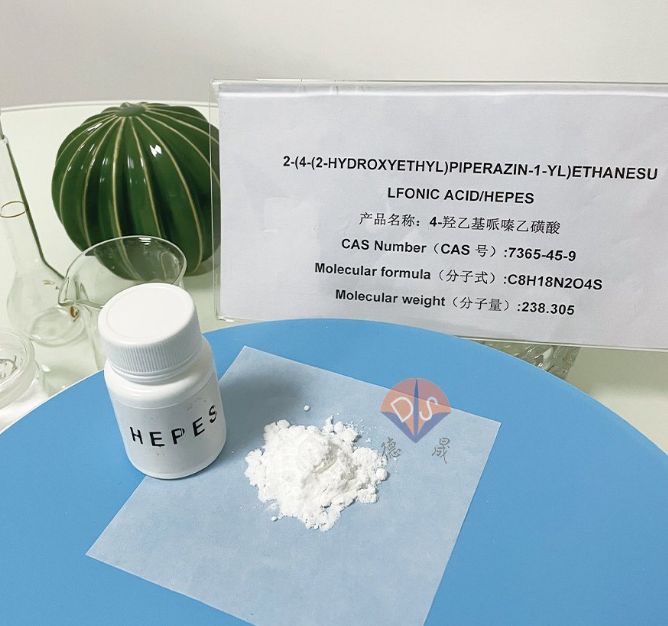Should we choose HEPES or Tris as the buffer solution? Desheng takes you to explore the application differences between the two
Release time:
2025-07-31
The selection of buffer solutions has a significant impact on experimental results in biochemistry and molecular biology research. Among them, HEPES and Tris are two commonly used buffering agents in the laboratory. Although they are all used to maintain the stability of solution pH, there are significant differences in chemical structure, applicable environment, and application scenarios. This article will provide a detailed comparison of HEPES and Tris from multiple dimensions using Desheng New Materials, helping researchers make more scientific reagent choices based on experimental needs.

HEPES powder
1、 Molecular structural differences: determining functional basis
HEPES is a zwitterionic compound containing a piperazine ring structure, which contains two ionizable groups and one sulfonic acid group in its molecule, exhibiting good zwitterionic properties in aqueous solution. This structure endows HEPES with excellent physiological compatibility and cell membrane penetration ability.
In contrast, Tris is composed of three hydroxymethyl groups and one primary amino group, and belongs to the weak base class of substances. Its structure is simple, easy to synthesize, and performs well under neutral to weakly alkaline conditions, but lacks the multifunctionality brought by the complex functional groups possessed by HEPES.
2、 Acid base buffering performance: applicable scope varies with emphasis
The advantage of HEPES lies in its stable buffering ability within the physiological pH range (approximately 6.8-8.2), making it widely used in experimental systems such as cell culture and protein transfection that require maintaining physiological conditions.
Tris is typically suitable for buffering environments between pH 7-9, especially in molecular biology experiments such as PCR reactions, protein electrophoresis, DNA extraction, etc. It is stable under neutral pH conditions but may be unstable in acidic and alkaline environments.
3、 Stability comparison: performance under different experimental environments
HEPES has good thermal and chemical stability, and can maintain performance over a wide temperature range and different hydration states; Tris is relatively stable in neutral environments, but may decompose under high temperature or extreme pH conditions, affecting its buffering effect.
4、 Solubility
HEPES has high water solubility, with a solubility of about 70 g/L in water, which means it can dissolve relatively easily in water and can be configured into solutions of higher concentrations. Tris is about 1 g/L, but it should be noted that this value varies with temperature, and at low temperatures, the solubility of Tris significantly decreases.
5、 Application scenario analysis: Each has its own strengths, depending on the needs
HEPES has been widely used in cell culture, protein delivery, liposome encapsulation, and virus vector preservation due to its good stability in the physiological pH range, especially in the emerging protein transfection technology in recent years. Tris, due to its neutral pH adaptability, has become the choice for many basic experiments, such as nucleic acid extraction, electrophoresis buffer, and other molecular biology routine operations.

Product packaging
In summary, although HEPES and Tris are commonly used buffering agents, they each have their own advantages in practical applications. Researchers should comprehensively consider and select suitable products based on factors such as experimental objectives, required pH range, and stability requirements. As a professional manufacturer of biological buffering agents, Desheng New Materials focuses on providing high-quality buffer raw materials, including high-purity HEPES and Tris series products. If you have any purchasing needs, please feel free to contact our professional customer service.
News
Contact details
Contact number
Address: C8, Guanggu United Science and Technology City, Ezhou City, Hubei Province
Fax:0711-3704 589
Follow us



